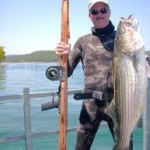Clear-water hunters comb depths of Arkansas reservoirs
In: Fishing
22 Aug 2010 Les Sage remembers the exact moment he got an eye-opening look at what he was going up against when he descended into an Ozark reservoir to go fishing with his spear gun.
Les Sage remembers the exact moment he got an eye-opening look at what he was going up against when he descended into an Ozark reservoir to go fishing with his spear gun.
“When I was just getting started, I was hunting in Beaver Lake and I noticed a largemouth bass acting peculiarly,” said Sage, 61, who lives in Joplin. “It kept darting around and then shot straight up like a Polaris missile and went completely out of the water.
“At first, I couldn’t figure out why it was acting that way. Then I caught movement and saw a huge striper swimming under my fins. It looked like a white refrigerator.
“My buddy and I surfaced, looked at each other and I said, ‘Did you see that? We’re going to need a bigger spear gun.’ ”
Forty years later, Sage carries a bigger spear gun. And those monstrous fish? They no longer seem as intimidating.
Get this: Fishing with his spear gun in clear-water Arkansas reservoirs such as Beaver, Bull Shoals and Norfork, Sage has taken an 80-pound flathead catfish, a 55-pound striper and an 18-pound walleye.
He has been dragged through the water by some fish, bear-hugged prey to get them to the surface and explored a side of the Ozarks that few ever see.
High adventure? You’d better believe it.
When Sage was young, he was intrigued by the television series “Sea Hunt” that starred Lloyd Bridges. Today, he is living that part.
“I’m just hopelessly addicted to this sport that incorporates hunting, fishing and diving into one,” he said. “To me, it’s just fascinating.”
• • •
Maybe the fascination with underwater fishing is in Sage’s blood.
From the time he was a young boy, he was intrigued with the sport.
It started when his dad bought him a mask and fins one Fourth of July, and Sage went off to explore the clear water of Big Sugar Creek in southwest Missouri.
“That mask opened up a whole new world for me,” he said. “We started off just looking at the bottom, but quickly started catching small turtles and watching the fish.”
By the time Sage was 16, he had purchased some used scuba gear and gotten his first spear gun. He and a buddy traveled to Beaver Lake in northwest Arkansas, and it wasn’t long before he shot his first fish.
That only served to stoke Sage’s fever. He went on to learn about each species’ habits, what it takes to get close enough to shoot them and where he had to be to get off a shot.
It might sound easy — descending into the middle of the lake and shooting a fish as it swims by. But that’s not the case at all.
First, most of Sage’s shots are at fish no more than 10 feet from the end of his gun. Getting that close to a skittish gamefish is no easy task.
Second, hunting fish with a spear gun often is a challenge unto itself. He uses a gun that is powered by, of all things, a rubber-band device. It sends a sharp-tipped spear speeding through the water with enough impact to go completely through a small- to medium-sized fish.
But that doesn’t always result in a quick kill. Sage can remember times when he has been dragged through the water, holding onto his gun with the heavy line attached to the spear.
He carries a sharp knife for two purposes: to finish off fish he can’t control or to cut the line if he gets in trouble.
“No fish is worth endangering your life over,” he said.
• • •
Sage started off as many spear fishermen do — with scuba gear to allow him to stay underwater for prolonged periods of time.
But when he noticed that his favorite prey, stripers, would spook from the bubbles and noise that scuba gear emits, he turned to free diving.
He holds his breath, descends, then tries to shoot a fish before he has to surface for air. The biggest advantage of that method is that it allows Sage ultimate stealth.
He will descend along flooded timber to break his profile, then lie motionless on the bottom. With no bubbles or movement, he seldom scares fish away.
The biggest disadvantage, of course, is that his time is limited. He only has one or two minutes, he said, to stalk and spear fish.
But he said that is normally sufficient if he has a good idea where fish are. He uses a large gun with a reel attached, so that he can release line and ascend to the surface to fight and retrieve larger fish.
“For stripers, I do best in 40 to 60 feet of water,” Sage said. “They prefer cooler temperatures, so they’re found deeper.
“Stripers are on the move; they’re constantly going. But they do relate to dropoffs, so that’s usually where I start.”
The 55-pound striper he shot at Beaver Lake wasn’t alone. It was part of a school. And Sage insists he isn’t telling fish stories when he says that his fish wasn’t the biggest one in the school.
“There were a couple that were bigger than the one I shot,” Sage said. “Beaver has some huge stripers in it, bigger than most fishermen realize.”
•••
Sage feels fortunate to live where he does.
Though Missouri and Kansas don’t allow gamefish to be taken with a spear gun, Arkansas does in many of its reservoirs. (The method is allowed only on the Arkansas side of lakes that straddle the state line.)
Spear fishermen in Arkansas can shoot everything from catfish to walleyes to stripers to crappies, but they’re limited to half the daily limit of a rod-and-reel fisherman.
The only exception is that black bass may not be taken at many reservoirs.
Because the Ozarks reservoirs are clear and deep, they amount to a diver’s paradise. And for spear fishermen, they are ideal hunting waters.
Sage has heard complaints that spear fishermen are depleting the resource and are hurting the population of big fish, but he disputes such allegations.
Though the popularity of spear fishing is growing, the number of fish taken by divers is still relatively insignificant. And with the reduced daily limits, there are safeguards against overharvest.
“We aren’t down there just slaughtering fish,” Sage said. “Most of the spear fishermen I know are very selective about the shots they take, and they are very conservative.
“We might shoot only one or two fish the entire day. I often go to Beaver and don’t shoot anything when I’m hunting for stripers.
“Spearfishing is a challenge. But it’s something I can’t get enough of.”
Source:
By BRENT FRAZEE
The Kansas City Star
Welcome to BeaverLakeBoaters!
This site is devoted to all things Beaver Lake Arkansas
Categories





Comments are closed.